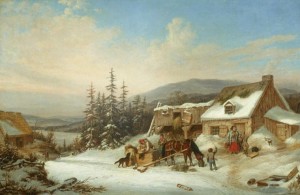You might find it a bit odd, a writer from the U.S. who is interested in the history of Canadian poetry, and I suppose it is just that: a bit odd. Years ago, during my grad school days, I started buying old Canadian poetry anthologies and scouring libraries for even older ones. Why? Well, at first it was just an interest in finding some forgotten writers that might inspire the work I was doing. However, as I began to pluck my way through these collections, I began to notice something curious that got me wondering about how nations develop their stories about themselves. And so began my study of Early Canadian poetry.
The history of Early Cana dian poetry, as written by many Canadian critics, is full of regrettable poetry made by remarkable poets. What is extraordinary about them, for the most part, is their mere existence. The first Canadian poetry anthology was compiled by the Reverend Edward Hartley Dewart [E. H. Dewart] in 1864.
dian poetry, as written by many Canadian critics, is full of regrettable poetry made by remarkable poets. What is extraordinary about them, for the most part, is their mere existence. The first Canadian poetry anthology was compiled by the Reverend Edward Hartley Dewart [E. H. Dewart] in 1864.
This was some 50 years before the modernism of Yeats, Eliot, and Pound arrived in Canada, opening the door for more poets to abandon the repetition of English Romantic and Victorian forms for something greater.
The opening statements of Dewart, a part-time poet and full-time preacher, make a rather inauspicious beginning for Canadian poetry. He writes, “My object in compiling this volume has been to rescue from oblivion some of the floating pieces of Canadian authorship worthy of preservation in a more permanent form.”
Several pages later, he adds the line, “In pronouncing judgment on the character of our native poetry, the most partial critic must confess that it is extensively marked by crudity and imperfection.” Together, these two statements create a clear image of the work that follows. Unlike many folks from later generations, Dewart has no delusions about poetry in early Canada: it is mostly forgettable.
Having spent some time reading early poetry from other English colonial nations, like the U.S. and Australia, I’d have to say the same tends to be true of them as well. It’s tough work stealing land and oppressing others in order to start a new nation.
Those people living in Canada that had time to write poetry were probably the only people who had the luxury to read the long-winded Romantics and Victorians coming out England. Let’s face it: when you’re chopping wood and carrying water just to have a meal, musing on William Wordsworth and Robert Browning probably aren’t on the daily planner.
Seventy-nine years and two dozen anthologies of Canadian poetry after Dewart’s collection, A. J. M. Smith opens his anthology with the words, “I have tried to present a more balanced view of the development of Canadian poetry as a whole than can be obtained from other anthologies.” Balanced. I like balanced. When the work week is finished and you still have a fair amount of energy. When the cup you placed on the pile of drying dishes stays. When your family budget isn’t twenty thousand dollars in the red. Yeah, you got to like balanced.
After about 20 pages of lukewarm praise for early Canadian poetry, Smith dramatically declares a quartet of early poets “Canada’s Golden Age.” However, while these poets had “delicate sensibility and often accurate feeling,” they also displayed “a good deal of rather commonplace thinking and conventional moralizing.” Not exactly the stuff of great nation building narratives, is it? Sounds more like an assessment of evangelical mega-church preachers if you ask me.
I’m not much of a nationalist. In fact, I’m probably amongst the most unpatriotic people around. When I was a little kid, I stumbled on some gifts that my parents were going to give me for Christmas. They were marked “Santa Claus,” which got me thinking about whether or not the jolly old fat guy was real. It didn’t take long to figure it out, and from that point on, I questioned most every story, even if I loved it. I could read something like the Narnia Chronicles, get lost in the fantasy, and yet still wonder why there was no “Narnia” on the maps. In fact, the more I studied geography, the more I found the lines that divided nations to be rather silly, even if the people on either side were clearly different.
 In the end, it seems to me that every nation is built on a pile of stories. Someone has to compose those stories, and usually those someones come after the true, complex history is made. Well-known author Margaret Atwood shared at least one deep desire with the compiler of the first Canadian poetry anthology: both wanted a rich literary tradition for Canada.
In the end, it seems to me that every nation is built on a pile of stories. Someone has to compose those stories, and usually those someones come after the true, complex history is made. Well-known author Margaret Atwood shared at least one deep desire with the compiler of the first Canadian poetry anthology: both wanted a rich literary tradition for Canada.
However, unlike Reverend Dewart, Margaret Atwood has been willing to buck the historical realities in favor of her own. This is probably most true in her collection of essays, Survival. Written during a wave of national exuberance and patriotism following the country’s centennial in 1967, Survival is a forceful effort to create heroes where none existed before.
One such hero is the poet Charles Sangster (1822-1893). You ever heard of him? Ever read any of his poems? I thought not. In taking up his longest poem, “The St. Lawrence and the Saguenay,” Margaret Atwood declares it “bad,” and then goes on to give it a few paragraphs of curious praise. She writes, “In any other country this … might be just bad poetry; here it’s bad poetry plus, and the plus is the doubtless unintended revelation of a split attitude [between a love of nature and a hatred of nature’s power over us].” What’s special about that? Just read a few commentaries about the oil spill in the Gulf of Mexico and you will find this tension. People have been struggling with this for thousands of years.
So, you might be thinking by now, who cares? I can understand that feeling. There are a lot of stories out there that don’t interest me either. However, what is interesting, and probably vitally important to all of us, is how the stories that we do fall in love with impact how we see the world.
 Take a look at the following comments Atwood makes about a poem written about indigenous Canadians by white poet Joseph Howe (1804-1873):
Take a look at the following comments Atwood makes about a poem written about indigenous Canadians by white poet Joseph Howe (1804-1873):
“The Americans … go for moral definitions based on intrinsic qualities the Indians are thought to possess; a rather racist approach. The Canadians, on the other hand, zero in on the relative places of Indians and whites on the aggression-suffering scale.”
Instead of providing an honest assessment of the decidedly racist literary treatment of indigenous people by early white Canadian poets, Atwood takes a poke at U.S. writers instead. The problem with most of the stories we fall in love with is that they are imbalanced. They are either too positive or too negative, and even in spirit, don’t quite hit the mark of reality. That’s why they are stories.
When I was about 11 years old, I took my little sister down to the basement and showed her where the Christmas gifts were. She was six years old, and still very much enthralled with Santa Claus. As I showed her the tags on the gifts, I saw her eyes grow wide, realizing the truth. It was a sad experience, one that probably should have happened a few years later, and yet it is a story that still lives on in my own family’s narrative.
In a lot of ways, I am no better than Margaret Atwood or any of those who came before her, because here I am telling a story that I love. And you out there ingesting all the stories of the world around kitchen tables, bar stools, fire pits, or computer screens, are really no better either. We all fall in love with certain stories, and then fail to remember their partial nature. That in the end, even the story we have about our own life is just that — a story.
Photo Credits
“The Habitant Farm” by Cornelius Kreighoff


Please Share Your Thoughts - Leave A Comment!